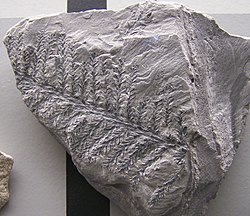| Walchia Temporal range: ~ | |
|---|---|
 | |
| Walchia piniformis | |
| Scientific classification | |
| Kingdom: | Plantae |
| Clade: | Tracheophytes |
| Clade: | Gymnospermae |
| Division: | Pinophyta |
| Class: | Pinopsida |
| Order: | † Voltziales |
| Family: | † Utrechtiaceae |
| Genus: | † Walchia Sternberg |
| Species | |
Walchia is a primitive fossil conifer found in upper Pennsylvanian (Carboniferous) and lower Permian (about 310-290 Mya) rocks of Europe and North America. A forest of in-situ Walchia tree-stumps is located on the Northumberland Strait coast at Brule, Nova Scotia.
Contents
Besides the Walchia forest, fallen tree trunks, and leaflet impressions, the forest, fossil-rich layer contains numerous, 4-legged, tetrapod fossil trackways.
